Sedum of Morgan - features of cultivation
Sedum, or sedum, Morgana is a succulent that is quite common in apartments, attracting flower growers with its interesting appearance. Due to the unusual hanging shape of the shoots and the numerous fleshy leaves, the people received the name "donkey's tail". It is quite unpretentious in care, and therefore it is considered the best option for beginners in growing green pets or that category of people who are rarely forced to be at home.
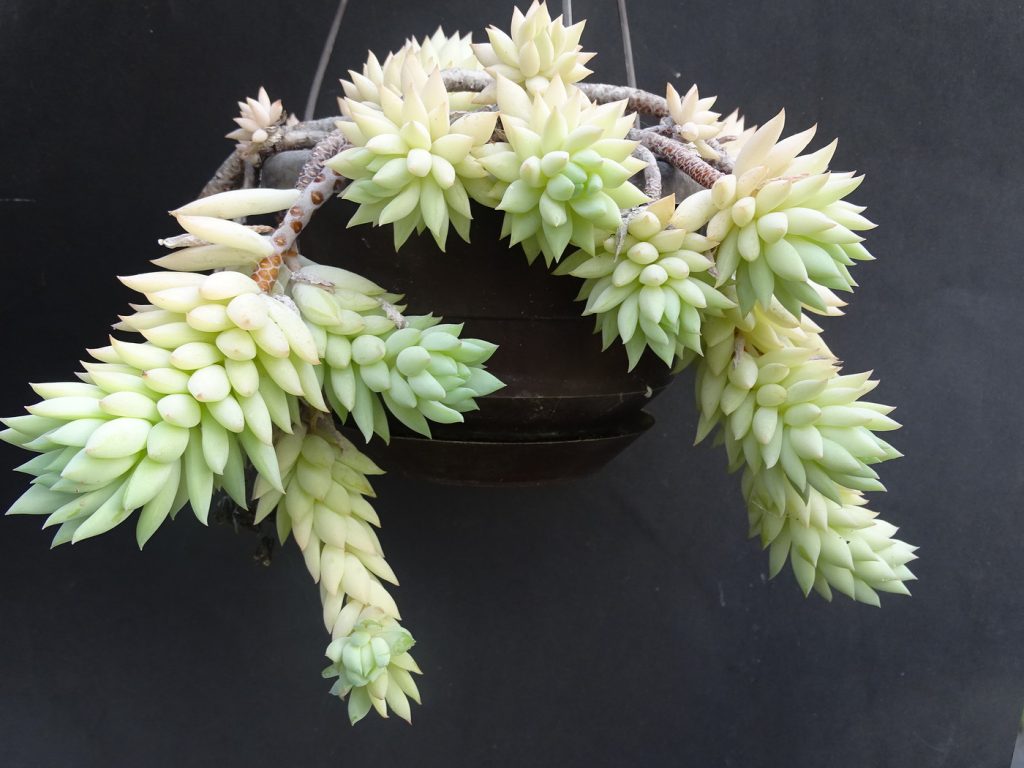
Sedum morgan home care
Description
The birthplace of the flower is South and Central America. Culture also grows in Mexico and Madagascar. It is a succulent, belongs to the Tolstyankov family. The botanical name is Sedum morganianum.
The plant is characterized by rather long stems that grow up to 1.2 m and hang down like whips. Does not form lateral shoots, grows due to the formation of basal segments.
The leaf plates are fleshy, thick, pointed at the tip. The length does not exceed 3 cm, taking into account the diameter up to 0.8 cm. They adhere tightly to the base, do not have petioles. Visually resemble the fangs or claws of animals.
The flower color ranges from green to gray-green or bluish. The surface is smooth, covered with a waxy coating that acts as a protective barrier from the sun's rays.
A distinctive feature of Sedum is its extreme fragility, which can shock novice florists. The leaves seem to snap off at the slightest touch, which is especially observed during the transplant process.
At home, it blooms extremely rarely, but abundantly. Basically, this phase occurs in the summer months and the first days of autumn. Inflorescences are arranged in clusters at the ends of the stems, to which they are attached with long pedicels. The buds are colored pink or purple.
Purchase and adaptation
When buying, you should carefully study the appearance of the succulent. There should be no plaque or stains on the surface of a healthy specimen, the leaves are not wrinkled and have a dense structure.
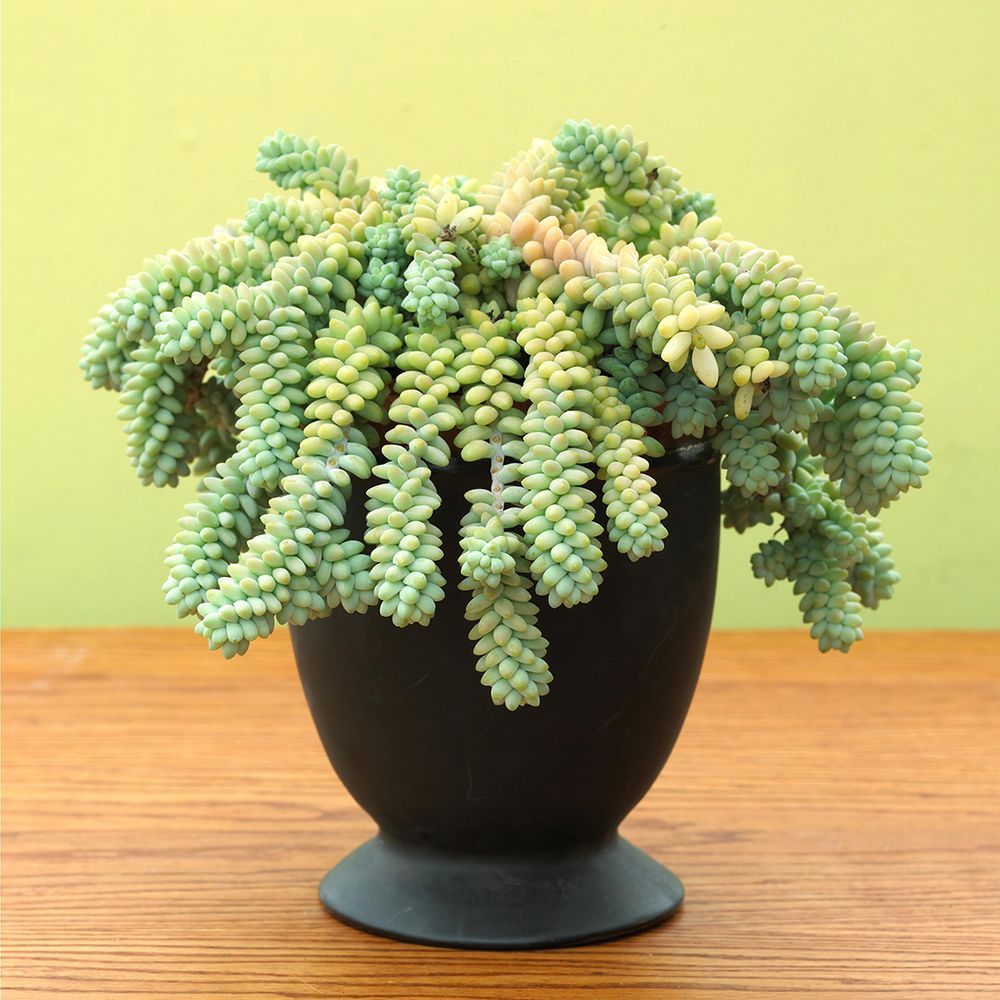
Sedum sedum morgana
When sedum is at home, it is better to place it in a room separate from all other plants for about 15-20 days.
During this period, it is realistic to fully diagnose the state of the plant and identify possible diseases or the vital activity of harmful insects.
Landing rules
For planting, it is preferable to take wide flowerpots that are small in depth, with the further possibility of hanging them, which will not injure the processes as they grow.
When choosing a container, it should be borne in mind that the root system of the succulent is located superficially and extremely rarely deepens into the ground by more than 10 cm.
During the event, a drainage layer is laid on the bottom of the new container.For it, it is allowed to use clay shards, crushed stone, pebbles, chipped bricks, polystyrene or expanded clay as a material.
This level should be at least 3 cm in thickness and occupy a volume not exceeding ⅓ of the total. After that, a small amount of the substrate is distributed, the plant is installed, the voids are filled with earth and watered.
Selection of soil and location
The culture prefers loose soil, with high levels of air and water permeability, as well as neutral in acidity. A universal composition for cacti and succulents is perfect for this purpose.
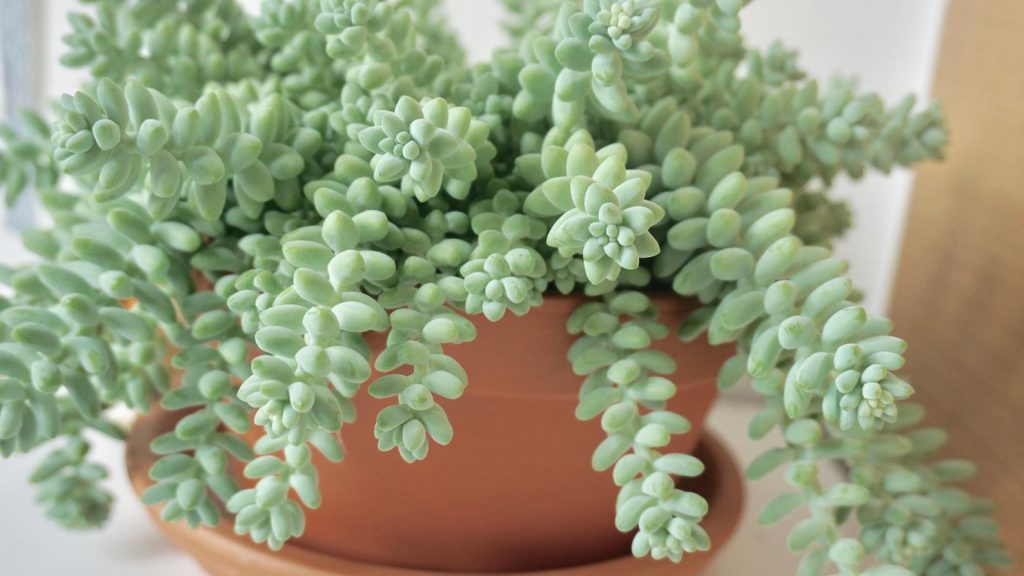
Sedum morgana photo
Also, the substrate can be prepared independently, for which it is mixed in the same proportions:
- coarse sand;
- peat;
- garden land.
It is better to place the pot on the southern windowsill or hang it in close proximity to it. A place with a south-east and south-west orientation is also suitable.
The north side does not fit at all, as a result of such a location, the Sedum will have stretching of shoots. In this case, the distance between the leaf plates increases, which significantly reduces the decorative effect of the culture.
The necessary conditions
A prerequisite for maintaining the external qualities of the succulent at the proper level is to recreate the most favorable indoor microclimate. This is quite simple to do, knowing the specific requirements of the plant.

Stonecrop morgan flower
Humidity
Moderate air humidity is most favorable, but Morgana is quite capable of tolerating a dry microclimate. Therefore, the flower does not need systematic spraying or water procedures under the shower.
Occasionally, sanitary cleaning is allowed by spraying a liquid with a finely dispersed spray gun and further wiping the sheet plates with a soft rag in order to eliminate settled dust. However, the process can only be carried out at a temperature not lower than 16 ° C.
Lighting
The key to the prosperity of culture is a large amount of sunlight and long daylight hours.
If such conditions cannot be provided in a natural way, the succulent is illuminated with fluorescent lamps, extending the light supply up to 10-12 hours.
Temperature
The temperature regime depends on the stage in which the flower is. From March to October, the indicators are maintained at the level of 18-28 ° C, in the rest of the period they are reduced to 13-16 ° C.
This approach allows the plant to enter a resting phase and gain strength before growing.
Care
Caring for the cleaning of Morgan at home does not imply any difficulties, the main thing is to correct it correctly in relation to the time of year.
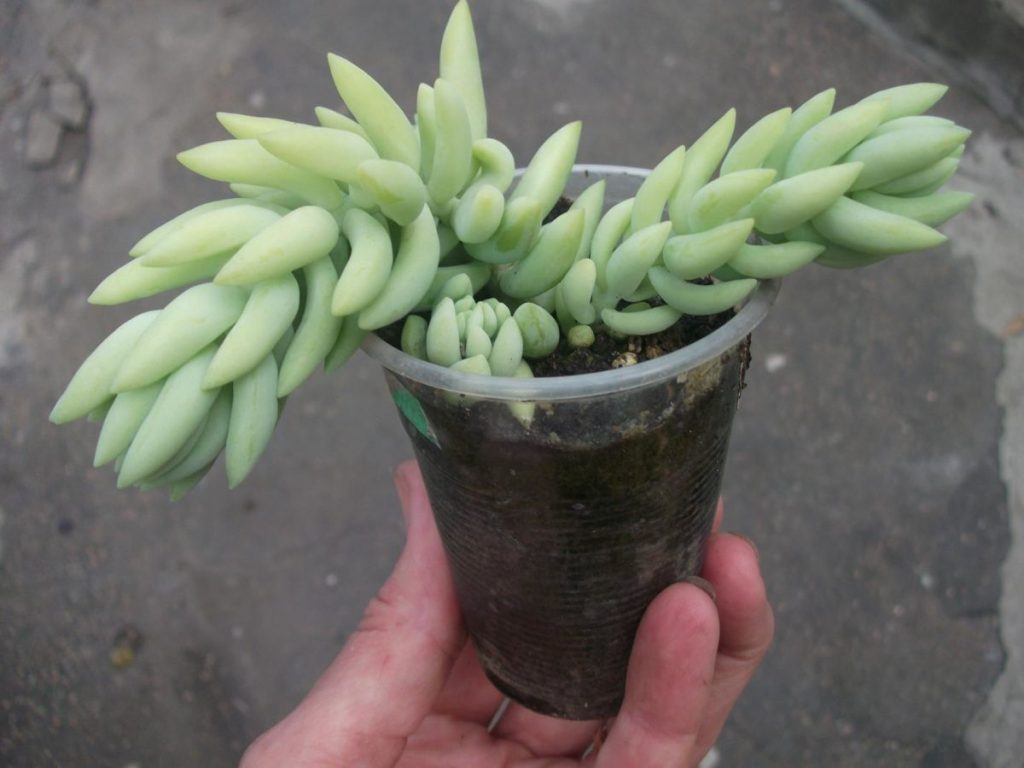
Sedum morgana reproduction
Top dressing
To build up green mass and maintain decorative characteristics at a high level, frequent feeding is not required. Complex preparations for cacti and succulents are used as fertilizers.
Funds are deposited with the following frequency:
- in the stage of active growth - 2 times a month;
- during the rest period at a temperature of 18-24 ° C - 1-2 times a month.
With a decrease in indicators to 13-18 ° C, the flower is not fertilized. The same applies to sick or pest-affected specimens.
Watering
As with all succulents, abundant watering and stagnant moisture are destructive for Sedum Morgan. Therefore, it is recommended to carry out the procedure only after the top layer of the soil has dried by 2 cm. In this case, complete drying of the substrate should be avoided. Otherwise, the leaves will shrivel and fall off.
During the dormant period, falling in autumn-winter, irrigation is minimized, especially if the indoor temperature drops. The soil is moistened only when the contents of the pot are half dry.
Water should be used only if it is settled for at least 15-20 hours or filtered.
Transfer
It is not necessary to transplant the Morgan sedum without urgent need due to the particularly fragile shoots of the flower.Transport to a new pot only if it becomes cramped in the old succulent.
On average, the event is held every 2-4 years, during which the plant feels quite comfortable in one place.
Pruning
Cropping the crop is not recommended. The exception is those cases when the shoots are strongly elongated and lose their attractiveness.
Manipulations are carried out regardless of the season with well-sharpened scissors or a knife. At the end of the procedure, the instruments and hands are thoroughly washed to remove the toxic juice.
Reproduction methods
Seeds
Seed propagation is extremely rarely practiced at home, because it is not always possible to create the necessary microclimate for the appearance of seedlings. In addition, the process takes a long time until the plants acquire the attractive appearance of an adult succulent.
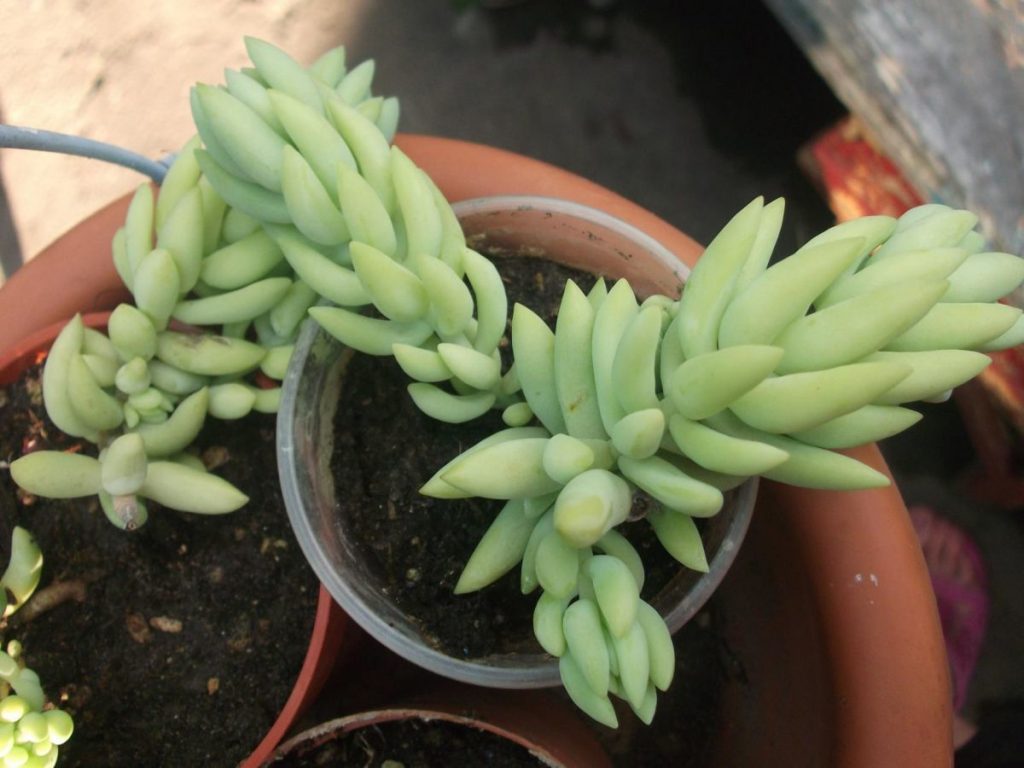
Sedum morgana planting and leaving photos
As a material, purchased seeds are used, which are distributed over the surface of the soil with a loose structure. Subsequently, the substrate is kept moist throughout the entire period of germination, preventing the formation of a dry crust.
The container is covered with glass or cellophane, placed in a lighted and warm place with a constant temperature of 24-28 ° C.
When the first shoots appear, the shelter is removed and the seedlings are cared for as for adult specimens.
Cuttings
Rooting technology for cuttings:
- Cut from above the processes 5-7 cm long, cleaned closer to the cut, dried for 1-2 days. You can also use fallen, but still productive leaves according to this principle.
- A universal soil for succulents or a mixture of earth and sand is poured into a small container. Moisturize.
- The cuttings are buried by 2 cm. In the case of rooting of leaf plates, they are laid out on the surface.
- They put the container in a warm, lighted place. Water as the earth dries up. After 3-5 weeks, the first signs of growth appear, propagation by leaves takes a longer time.
Dividing the bush
One of the simplest methods of reproduction, it can be carried out in the process of plant transplantation.
To do this, the mother bush is cut with a knife into the required number of parts, the cut sites are treated for disinfection with crushed activated carbon and dried for a couple of hours. After the delenki, they are distributed in separate flowerpots and watered.

Succulent sedum morgan
If, during the procedure, the processes are damaged and, as a result, the stem is exposed, such segments are cut off, because new leaf plates are not subsequently formed in this area.
Diseases and pests
Often, the cultivation of Sedum is accompanied by a number of mistakes that novice florists make due to their inexperience. To avoid incidents, you should know the reasons for their occurrence and, if necessary, take immediate measures to resolve them.
| Problem | Cause | Solution method |
| Loss of attractiveness by shoots, an increase in the distance between leaf blades | Light starvation | Move the pot to a lighter place / illuminate with phytolamps |
| Excessive mineral content in the soil due to too frequent fertilizing | Increase the intervals between soil fertilization / reduce the concentration of drugs several times | |
| Leaves fall | High temperature / heating season in winter | Transferred to a cool place / artificially reduce indicators |
| Moisture deficiency | Normalize the irrigation system | |
| Mechanical damage | Eliminate any impact unnecessarily | |
| Leaves become shriveled, fall off | Insufficient watering | Adjust the frequency of irrigation |
| Decay, mold, softening and yellowing of leaves | Excess moisture | Regulate the irrigation system. They are transplanted, while the injured segments are removed and disposed of. |
| High humidity | Sanitary cleaning is minimized, sprayed no more than 1 time per month. If necessary, rearrange to a place remote from air humidifiers. | |
| Rapid wilting of the plant | Root worm | The damaged parts are cut off, the healthy ones are treated with infusion of tobacco or calendula, and transplanted. |
| Nematodes, aphids | Infected land, transfer from other indoor plants | Treat with a solution of laundry soap. With extensive lesions - Aktellik (the procedure is carried out twice with an interval of 7-10 days). In the event that it was not possible to get rid of the pests with a chemical preparation, the succulent should be rooted using healthy cuttings. |
| Fungus | Increased humidity of the substrate and air | Areas with dark spots are stopped and burned. |

